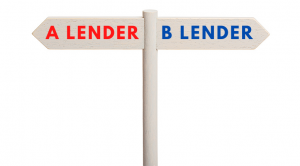An insight into differences of A LENDERs, B LENDERs, and PRIVATE LENDERs

People will often ask if a mortgage is with an A or B lender; however, few are aware of what these terms mean. The big banks will often refer to themselves as A lenders (which they are) with all others being B lenders in an attempt to make themselves sound superior.
The truth is that this has nothing to do with the quality of the lender. It has to do with the profile of the client.
A lenders cater to borrowers with good credit and qualifying income. B lenders cater to borrowers who do not fit within the guidelines of an A lender. People with poor credit, non-qualifying income, or other challenges would be declined by an A lender, but they are perfect candidates for B lenders.
How much downpayment do you need?
A lenders look for qualifying credit and income. They offer insured mortgages so their minimum required downpayment is as low as 5%. B lenders focus more on the down payment. The minimum down payment with a B lender is 20%; however, each application is assessed individually, and down payment/equity requirements can vary by the application. In some cases, the lender may require 25, 30, or even 35% down payment/equity in the property for them to consider lending on it.
Where is the property located?
Location is another important consideration. B lenders have a preference for properties in larger areas, as they consider them to be more saleable. A home in Toronto would be of more interest to them than a home in Parry Sound for example. The further away from a metropolitan area, the harder it can be to find a B lender interested in lending on that property.
How Mortgage Rates Differ Between A and B Lenders
As B lenders are taking on more risk, their rates are approximately 1.25% – 2% higher than rates from A lenders. B lenders will usually charge a 1% lender fee as well. They are meant to be short term solutions, so the term length is usually only one or two years. The idea is to convert your mortgage to an A lender at significantly lower rates once your credit or income situation improves. Every situation is a little different, however.
Could an A Lender Also Be a B lender?
Yes, that’s right!
Many A lenders will also have a B division, just as some B lenders have A divisions. Therefore, they can be an A lender and a B lender at the same time. They will usually lean to one side more than the other, and each side would have its own unique rules and guidelines.
Most monoline lenders fall into the A lenders’ category. And most of them also have strong B divisions. Monoline lenders are a great alternative for banks by offering competitive rates and having lower penalties.
Private Lenders
There are always going to be situations where some may not qualify with either an A or a B lender. In these cases, private lenders are there to pick up the slack. Private lenders are generally (but not always) individuals looking to invest their money in mortgages. Rates are often between 7-8% on first mortgages or 10-13% on 2nd mortgages. Private lenders will often charge a 1% fee, but in some situations, the fee can be higher. While brokers get paid by A and B lenders, we don’t get paid anything by privates, which means there will be a fee from the broker as well. While private mortgages are the most expensive, they can bail people out of sticky situations without them needing to sell their homes.
Sometimes bad things happen to good people, and even the most solid and creditworthy individuals can go through rough patches where they need a temporary bailout. B lenders and private lenders can fill this requirement until they get their lives back on track.
By Paul Meredith| Mortgage Broker